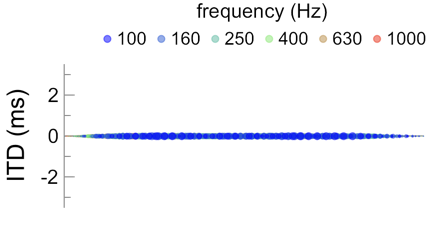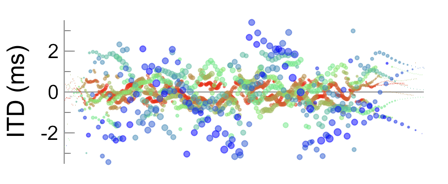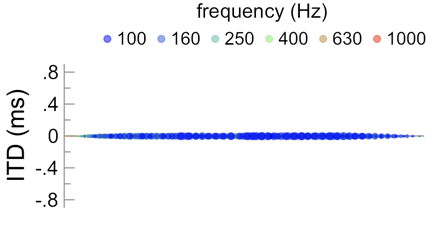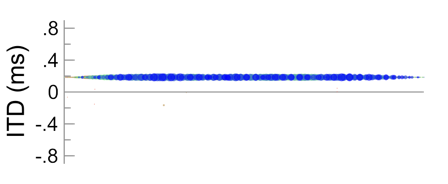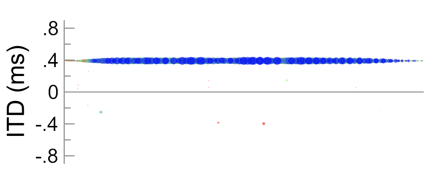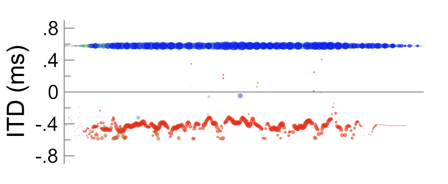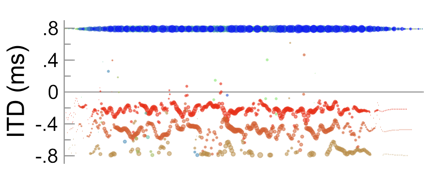The edge model describes how auditory spatial cues may be represented by neural activities.
Spatial hearing under ideal listening conditions, when spatial cues recur over time, can be explained by a broad variety of acoustic and neural models, including the edge model.
What distinguishes the edge model from alternative models is that representations are also consistent with spatial hearing under typical listening conditions, when spatial cues are likely to fluctuate over time. Only the edge model, for instance, is consistent with spatial hearing when interaural time differences (ITD) are broadly distributed over time or when polarity is inverted in addition to when values recur over time.
Under the edge model, neural activities along the contralateral slopes of spatially selective neurons in the left hemisphere encode the right-hand ‘edges’ of auditory objects, whereas right hemisphere activities encode the left-hand edges of the same objects. Under ideal listening conditions, these two contralaterally encoded edges overlap. Under typical listening conditions, however, when spatial cues are likely to fluctuate, the two edges split apart prompting left and right edges.
Another analogy for the edge model may be a topographic ‘relief’ map, where relief from the left-hand perspective is encoded in the right hemisphere and relief from the right-hand perspective is encoded in the left hemisphere.
Below, the edge model is compared with alternative models while only considering interaural time differences (ITD) across carrier waveforms. More advanced topics and aspects of the edge model may be found at the following links.
Comparisons of representations - interaural time differences (ITD) across carrier waveforms at low frequencies
Acoustic model of spatial hearing
Neural models of spatial hearing
Generalized midbrain activity patterns used to compare neural models
Comparisons between neural models
Corollaries of the edge model
To compare neural models using experimentally generated or binaurally recorded acoustic signals, we must first consider the relative contributions to spatial hearing from recent and prior spatial cues and neural activities. Commonly used schemes are to combine waveforms, cues, or neural activities within a sliding time-frame or to apply adaptive processes resembling exponential or power functions shaped by predetermined time-constants.
The edge model suggests an alternative scheme where the relative contributions to spatial hearing from prior spatial cues are diminished as determined by the extent to which current neural activities exceed a maximum activity limit or threshold, beneath which intermediate activity levels are defined and the edges of auditory objects are encoded. Under this scheme, prior contributions to spatial hearing diminish faster when the activity limit is lowered and diminish slower when the limit is raised.
Weights ascribed to waveform amplitude or changes in amplitude that exceed maximal limits or thresholds may similarly determine when neural responses are evoked in individual spatially-selective neurons.
Although unnecessary under the edge model when interaural level differences (ILD) are also considered, spatial ambiguities could be indicated and possibly ‘suppressed’ when sub-maximal activities in one hemisphere are ipsilateral to those in the opposite hemisphere, or equivalently, when activities are evoked by the ipsilateral slopes of neurons.
Psychoacoustic support for the edge model of spatial hearing
Modeling ITD while ignoring interaural level differences (ILD)
Several issues arise when modeling ITD while ignoring ILD.
Broad distributions of ITDs and values for peripheral directions that recur over time, for instance, may not be fully encoded by peripheral neuron ‘labels’.
Recurring ITDs for peripheral directions in frequency bands above ~500 Hz may also produce phase-ambiguous edges.
IPDs derived from waveform envelopes are also often broadly distributed, which brings us back to the first issue: that edges may not be fully encoded by peripheral neuron ‘labels’.
To a large extent, these issues (and others) are resolved by incorporating neural responses the interaural level differences (ILD).
Binaural recording models (ITD alone, activities due to ILD and envelope cues excluded)


